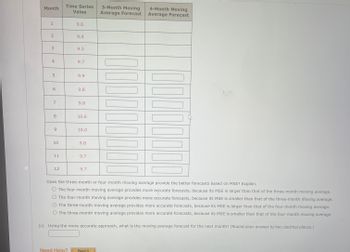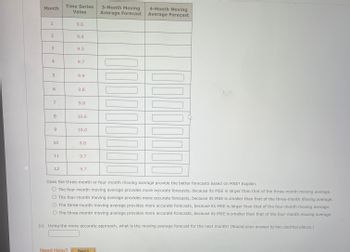
MATLAB: An Introduction with Applications
6th Edition
ISBN: 9781119256830
Author: Amos Gilat
Publisher: John Wiley & Sons Inc
expand_more
expand_more
format_list_bulleted
Question

Transcribed Image Text:**Time Series Analysis and Moving Averages**
This document details a time series analysis where moving averages are used to forecast future values. The table is organized with four main columns:
1. **Month**: Sequential month numbers from 1 to 12.
2. **Time Series Value**: Recorded values for each month ranging from 9.4 to 10.6.
3. **3-Month Moving Average Forecast**: Averages based on the preceding three months.
4. **4-Month Moving Average Forecast**: Averages based on the preceding four months.
**Incomplete Data:**
- The table for the 3-month and 4-month moving averages is not filled out.
**Forecast Evaluation:**
Below the table, there's a question about which moving average provides better forecasts based on Mean Squared Error (MSE):
- The options indicate choices between 3-month and 4-month moving averages, considering whether the MSE is smaller or larger.
**Question:**
Using the more accurate approach identified, calculate the moving average forecast for the next month, rounding to two decimal places.
**Note**: The document does not provide the completed calculations or the resulting MSE, so calculation details are omitted.
**Additional Help:**
- A "Need Help?" section is present for further guidance.
This educational material invites learners to apply concepts of moving averages and evaluate forecasts using statistical measures like MSE.

Transcribed Image Text:### Transcription for Educational Website
#### Time Series Data and Moving Average Forecast
This table displays the time series data for a duration of 12 months along with columns for calculating the 3-month and 4-month moving averages for forecasting purposes. The values are presented as follows:
- **Month**: Sequential number from 1 to 12.
- **Time Series Value**: Data points for each month.
- **3-Month Moving Average Forecast**: Calculated forecast using the average of the previous three months.
- **4-Month Moving Average Forecast**: Calculated forecast using the average of the previous four months.
#### Data Overview:
| Month | Time Series Value | 3-Month Moving Average Forecast | 4-Month Moving Average Forecast |
|-------|--------------------|--------------------------------|--------------------------------|
| 1 | 9.6 | | |
| 2 | 9.4 | | |
| 3 | 9.5 | | |
| 4 | 9.7 | | |
| 5 | 9.9 | | |
| 6 | 9.8 | | |
| 7 | 9.8 | | |
| 8 | 10.6 | | |
| 9 | 10.0 | | |
| 10 | 9.8 | | |
| 11 | 9.7 | | |
| 12 | 9.7 | | |
#### Analytical Question:
- Does the three-month or four-month moving average provide better forecasts based on Mean Squared Error (MSE)? Explain.
- The four-month moving average provides more accurate forecasts because its MSE is larger than that of the three-month moving average.
- The four-month moving average provides more accurate forecasts because its MSE is smaller than that of the three-month moving average.
- The three-month moving average provides more accurate forecasts because its MSE is larger than that of the four-month moving average.
- The three-month moving average provides more accurate forecasts because its MSE is smaller than that of the four-month moving average.
#### Further Calculation:
(c) Using the more accurate approach, calculate the moving average forecast for the next month. (
Expert Solution
arrow_forward
Introduction
Moving Averages are a forecasting tool that work by projecting the data value for a specific time based on the dataset's monthly average values.
For instance, to estimate the value of the data for period n when generating 3 month Moving Averages (MA), we would use the following formula.
Step by stepSolved in 2 steps

Knowledge Booster
Similar questions
arrow_back_ios
arrow_forward_ios
Recommended textbooks for you
 MATLAB: An Introduction with ApplicationsStatisticsISBN:9781119256830Author:Amos GilatPublisher:John Wiley & Sons Inc
MATLAB: An Introduction with ApplicationsStatisticsISBN:9781119256830Author:Amos GilatPublisher:John Wiley & Sons Inc Probability and Statistics for Engineering and th...StatisticsISBN:9781305251809Author:Jay L. DevorePublisher:Cengage Learning
Probability and Statistics for Engineering and th...StatisticsISBN:9781305251809Author:Jay L. DevorePublisher:Cengage Learning Statistics for The Behavioral Sciences (MindTap C...StatisticsISBN:9781305504912Author:Frederick J Gravetter, Larry B. WallnauPublisher:Cengage Learning
Statistics for The Behavioral Sciences (MindTap C...StatisticsISBN:9781305504912Author:Frederick J Gravetter, Larry B. WallnauPublisher:Cengage Learning Elementary Statistics: Picturing the World (7th E...StatisticsISBN:9780134683416Author:Ron Larson, Betsy FarberPublisher:PEARSON
Elementary Statistics: Picturing the World (7th E...StatisticsISBN:9780134683416Author:Ron Larson, Betsy FarberPublisher:PEARSON The Basic Practice of StatisticsStatisticsISBN:9781319042578Author:David S. Moore, William I. Notz, Michael A. FlignerPublisher:W. H. Freeman
The Basic Practice of StatisticsStatisticsISBN:9781319042578Author:David S. Moore, William I. Notz, Michael A. FlignerPublisher:W. H. Freeman Introduction to the Practice of StatisticsStatisticsISBN:9781319013387Author:David S. Moore, George P. McCabe, Bruce A. CraigPublisher:W. H. Freeman
Introduction to the Practice of StatisticsStatisticsISBN:9781319013387Author:David S. Moore, George P. McCabe, Bruce A. CraigPublisher:W. H. Freeman

MATLAB: An Introduction with Applications
Statistics
ISBN:9781119256830
Author:Amos Gilat
Publisher:John Wiley & Sons Inc

Probability and Statistics for Engineering and th...
Statistics
ISBN:9781305251809
Author:Jay L. Devore
Publisher:Cengage Learning

Statistics for The Behavioral Sciences (MindTap C...
Statistics
ISBN:9781305504912
Author:Frederick J Gravetter, Larry B. Wallnau
Publisher:Cengage Learning

Elementary Statistics: Picturing the World (7th E...
Statistics
ISBN:9780134683416
Author:Ron Larson, Betsy Farber
Publisher:PEARSON

The Basic Practice of Statistics
Statistics
ISBN:9781319042578
Author:David S. Moore, William I. Notz, Michael A. Fligner
Publisher:W. H. Freeman

Introduction to the Practice of Statistics
Statistics
ISBN:9781319013387
Author:David S. Moore, George P. McCabe, Bruce A. Craig
Publisher:W. H. Freeman